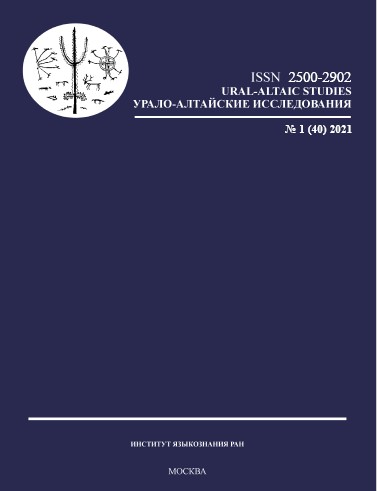Графический анализ вокализма первого слога в ненецких словарях из архива А. М. Шёгрена
The graphic analysis of the first syllable vowel system in Nenets dictionaries from A. M. Sjögren’s archive
Author(s): Polina I. LiSubject(s): Phonetics / Phonology, Morphology, Lexis, Historical Linguistics, Comparative Linguistics, Finno-Ugrian studies, 18th Century
Published by: Институт языкознания Российской академии наук
Keywords: Nenets language; first Nenets dictionaries; historical phonology; graphics; first syllable vowel system;
Summary/Abstract: This article describes the graphic features of the first syllable vowels in Pustozersk and Obdorsk dictionaries from A. M. Sjögren’s archive. The graphic analysis is carried out against the background of the Proto-Samoyed reconstructions by J. Janhunen, Nenets current literary norm, “Nenets-Russian Dictionary” by N. M. Tereschenko, “A Morphological Dictionary of Tundra Nenets Language” by T. Salminen, and “Dialectal Dictionary of the Nenets Language” by S. I. Burkova et al. The dialectal features of the dictionaries are compared to the modern ones. The area of the Pustozersk region is referred to as the territory where the central (Bolshezemelskiy) dialect is spoken. In one word the graphic representation of the 18th century Pustozersk dictionary coincides with the form of the modern Eastern dialect word. At the same time, in another word, the Western variant is attested. The territory where the Obdorsk dictionary was recorded is the territory where the speakers of the Eastern dialects of the Nenets language reside. In the Obdorsk dictionary, a variant that coincides with the Eastern variant is recognized. Some outstanding consonant features of the first syllable are also taken into consideration. For example, in the Pustozersk dictionary, the initial /ŋ/ is not represented graphically, as in Proto-Samoyedic reconstructions. The Obdorsk dictionary contains three graphic variants of the modern initial /ŋ/. The results are presented in comparison tables. The word examples are presented accordingly. In many ways, the reflexes presented in the Pustozersk dictionary correspond with modern ones. The reconstructed diphthongoids are graphically represented by the diphthongs in the Pustozersk dictionary, which is not the case for modern dictionaries. In comparison with modern dictionaries, reflexes in the Obdorsk dictionary are more diverse. The diphthongs are also used in the place of reconstructed diphthongoids.
Journal: Урало-алтайские исследования
- Issue Year: 2021
- Issue No: 01 (40)
- Page Range: 47-60
- Page Count: 14
- Language: Russian

